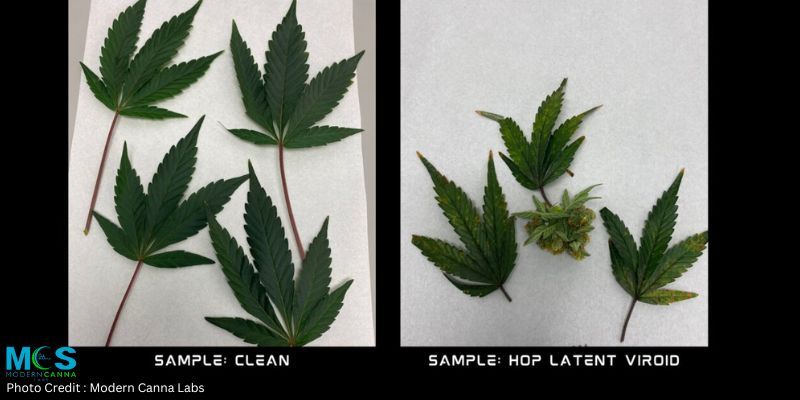
Hop Latent Viroid: Understanding the Impact on Cannabis
When cultivating cannabis, it is important to provide an environment where your plants can thrive and will be protected against pests and disease. Most cannabis growers are aware of the common threats to cannabis, like aphids, mold, mildew, root rot and the importance of maintaining clean growing conditions with the right nutrients, temperature, and humidity level. But one threat that we don’t hear too much about is Hop Latent Viroid, also known as HLVd.
What is Hop Latent Viroid (HpLVd)?
Hop Latent Viroid is an infectious agent that has been known to affect a variety of crops, but its discovery in cannabis plants has raised questions about its seriousness and impact on the cannabis industry. Hop Latent Viroid is a single-stranded, circular RNA molecule that belongs to the family Avsunviroidae. It was first identified in hop plants (Humulus lupulus), where it caused significant economic losses in the hop industry, causing reduced yields and compromised quality. Its presence in cannabis plants, however, has raised concerns since it has the potential to cause similar negative effects on this valuable crop.
The viroid is known to be transmitted through infected plant material, including seeds, cuttings, and vegetative propagules. Once it finds its way into a cannabis plant, it can remain undetected for long periods, making it a silent threat for growers who may unknowingly be propagating infected plants.
Symptoms and Detection
One of the challenges of dealing with Hop Latent Viroid is its elusive nature. Infected cannabis plants may not exhibit obvious symptoms, especially during the early stages of infection. This makes it difficult for growers to identify infected plants with the naked eye.
As the infection progresses, however, some common symptoms may become apparent. These include stunted growth, reduced leaf size, yellowing of leaves, and an overall decline in plant health. In severe cases, infected plants may experience premature flowering and reduced bud development, leading to decreased yields. This is also known as “dudding disease” or Putatitive Cannabis Infectious Agent (PCIA).
To accurately detect the presence of HpLVd, specialized laboratory tests such as reverse transcription-polymerase chain reaction (RT-PCR) are required. These tests can identify the presence of the viroid even in asymptomatic plants, allowing growers to take necessary measures to prevent further spread.
Impact on Cannabis Cultivation
The discovery of Hop Latent Viroid in cannabis has raised concerns among growers and the industry as a whole. While some studies suggest that the viroid may not cause significant yield losses in cannabis as it does in hops, its impact on overall plant health and the potential for reducing yields are still valid concerns for cultivators.
The presence of HpLVd in cannabis crops can have far-reaching consequences for the industry. Many countries and states have strict regulations concerning the cultivation and distribution of cannabis, and the detection of infectious agents like HpLVd can lead to mandatory crop destruction or quarantine measures to prevent further spread.
Prevention and Management of HpLVd
As with any infectious agent, prevention is crucial in dealing with Hop Latent Viroid. Growers should take proactive measures to minimize the risk of introducing infected plants into their cultivation operations. This includes sourcing plant material from reputable and certified nurseries, implementing quarantine protocols for new plants, and regularly testing crops for the presence of viroids and other pathogens.
In cases where HpLVd is detected in a cannabis crop, growers must take immediate action to prevent its spread. This may involve removing and destroying infected plants, sanitizing equipment and tools to prevent transmission, and implementing strict hygiene practices to maintain a clean growing environment.
The presence of Hop Latent Viroid in cannabis cultivation is a cause for concern, but it is not a reason to panic. With proper prevention, detection, and management strategies, growers can mitigate the impact of this viroid on their crops. Regular testing and adherence to best practices will not only protect individual cultivation operations but also contribute to safeguarding the cannabis industry as a whole. As researchers continue to study HpLVd and its interaction with cannabis plants, cultivators should stay informed and be prepared to adapt their practices accordingly, ensuring a sustainable and thriving cannabis cultivation community.
The best way to prevent Hop Latent Viroid is to start your grow with seeds instead of clones and maintain a clean environment. Get the best seeds online from The Seed Cellar, delivered in original breeder packaging with a germination guide. Check out The Seed Cellar, one of the largest online Cannabis seed banks and grow high-quality cannabis plants from high-quality, clean cannabis seeds.

